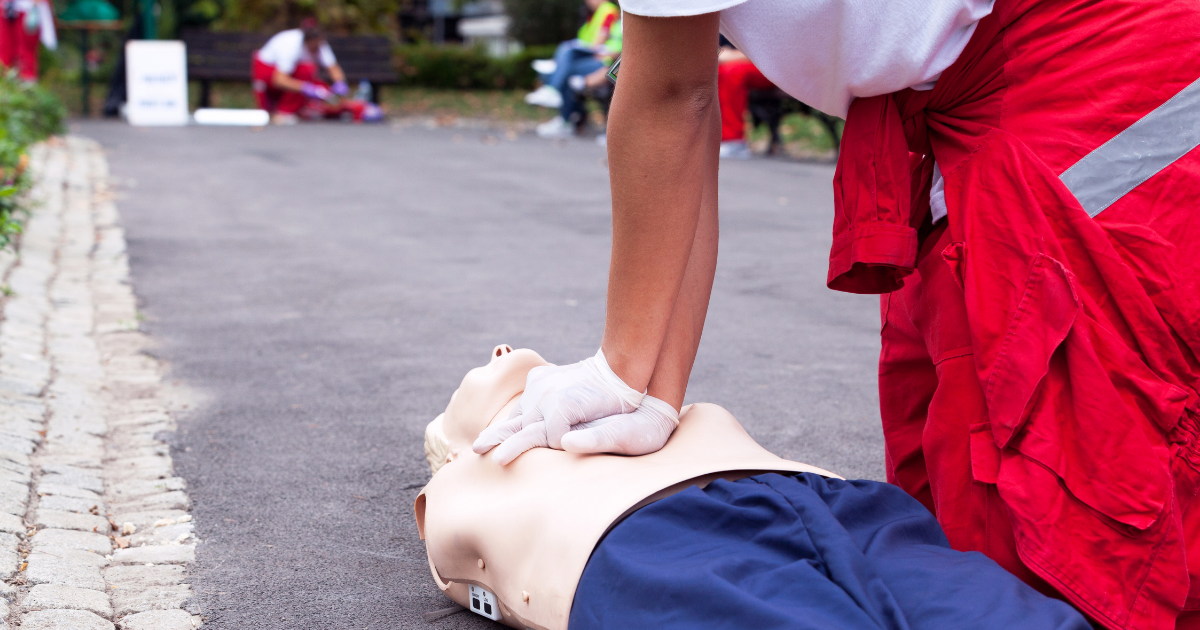Nearly three-quarters (70%) of cardiac arrests that don’t happen in hospitals happen in homes. If someone in your home needed cardiopulmonary resuscitation (CPR), would you know what to do? What if it was your child?
During cardiac arrest, the heart stops pumping oxygenated blood to the brain and other organs. CPR is an emergency lifesaving procedure that uses chest compressions and/or mouth-to-mouth breathing to push oxygen-rich blood to the brain and major organs when the heart stops beating. An automated external defibrillator (AED) is a device that checks a person’s heart rhythm and determines if a shock is needed to restore proper rhythm. Often available in public places like airports, gyms, hotels and stadiums, AEDs use voice prompts, lights and display messages to guide responders on how to use the equipment.
“An AED works to restore a normal heart rhythm, while CPR keeps blood moving to the organs and brain to keep them nourished,” explained Jennie Allen-Rich, M.D., a pediatric cardiologist with Pediatrix® Northwest Congenital Heart Care.
For children who suffer sudden cardiac arrest, CPR and/or an AED can significantly improve survival if performed in the first few minutes, according to the American Heart Association. While having AEDs in places like schools and daycare facilities is important, ensuring that adult caregivers in those locations have appropriate training to use the equipment is paramount.
“Little kids need AED chest pads that fit them properly and deliver the correct amount of electricity,” said Dr. Allen-Rich. “An AED is not one-size-fits-all, so making sure someone is trained to use a kid-sized device is very important.”
Tips for parents of children newly diagnosed with a cardiac condition
Pediatric cardiologists like Dr. Allen-Rich treat infants and children with congenital conditions — heart problems present at birth — and heart disease that develops later in a child’s life. Examples of congenital heart defects include holes or windows within the heart or heart valves that form abnormally and don’t function as they should. Children can also develop heart disease through inflammatory conditions, such as Kawasaki disease and multisystem inflammatory syndrome (MIS-C), an illness linked to COVID-19.
Children with known heart problems are often at higher risk of sudden arrest. For example, children with an underlying arrhythmia or cardiomyopathy are predisposed to sudden cardiac arrest, according to Dr. Allen-Rich. Any child who has had heart surgery also is at higher risk since scar tissue or altered blood flow can cause the heart to have trouble pumping blood. If your child has been recently diagnosed with a cardiac condition, you may feel less anxiety about caring for your child if you know how to perform CPR.
“I firmly believe that all parents and caregivers should prepare for bringing any child home by learning CPR,” Dr. Allen-Rich said. “Being trained in CPR provides knowledge and confidence to stay calm in a medical emergency and help a child in need. A respiratory or cardiac arrest happens so quickly, and an immediate response can dramatically affect a child’s chances of survival.”
In fact, Dr. Allen-Rich says that every minute that a cardiac arrest victim does not receive CPR increases their chance of dying by 10%.
CPR can save children who don’t have heart issues, too
Even in healthy kids, accidents can happen. A toddler could fall into a pool or choke on a hot dog, turning a normal day into an emergency. However, an adult certified in CPR can help improve a child’s chance of survival by intervening while 911 is on the way.
Learn more about CPR
CPR & AED Awareness Week (June 1-7) is the perfect time to cross “Learn CPR” off your to-do list. The American Heart Association’s Heartsaver® Pediatric First Aid CPR AED Course is designed for people without prior medical training. Through the program, you’ll learn what to do if an infant or child suffers a medical emergency.
“Having to step in and start CPR for a child is one of the most terrifying experiences one can have, and it’s very hard to think clearly when someone’s life is on the line,” Dr. Allen-Rich explained. “Getting trained to perform CPR and taking regular refresher courses can help decrease the panic that’s inevitable when you see a loved one in cardiac arrest. Learning CPR is a simple exercise that can give you the power to save someone you love.”
Pediatrix Medical Group’s board-certified pediatric cardiologists treat infants, children and teens with various heart conditions. Find a practice.
